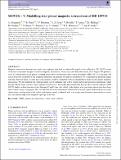MOVES – V. Modelling star–planet magnetic interactions of HD 189733
Abstract
Magnetic interactions between stars and close-in planets may lead to a detectable signal on the stellar disc. HD 189733 is one of the key exosystems thought to harbour magnetic interactions, which may have been detected in 2013 August. We present a set of 12 wind models at that period, covering the possible coronal states and coronal topologies of HD 189733 at that time. We assess the power available for the magnetic interaction and predict its temporal modulation. By comparing the predicted signal with the observed signal, we find that some models could be compatible with an interpretation based on star–planet magnetic interactions. We also find that the observed signal can be explained only with a stretch-and-break interaction mechanism, while that the Alfvén wings scenario cannot deliver enough power. We finally demonstrate that the past observational cadence of HD 189733 leads to a detection rate of only between 12 and 23 per cent, which could explain why star–planet interactions have been hard to detect in past campaigns. We conclude that the firm confirmation of their detection will require dedicated spectroscopic observations covering densely the orbital and rotation period, combined with scarcer spectropolarimetric observations to assess the concomitant large-scale magnetic topology of the star.
Citation
Strugarek , A , Fares , R , Bourrier , V , Brun , A S , Réville , V , Amari , T , Helling , C , Jardine , M , Llama , J , Moutou , C , Vidotto , A A , Wheatley , P J & Zarka , P 2022 , ' MOVES – V. Modelling star–planet magnetic interactions of HD 189733 ' , Monthly Notices of the Royal Astronomical Society , vol. 512 , no. 3 , pp. 4556-4572 . https://doi.org/10.1093/mnras/stac778
Publication
Monthly Notices of the Royal Astronomical Society
Status
Peer reviewed
ISSN
0035-8711Type
Journal article
Description
Funding: AS acknowledges funding from the European Union’s Horizon-2020 research and innovation programme (grant agreement no. 776403 ExoplANETS-A), the PLATO/CNES grant at CEA/IRFU/DAp, and the Programme National de Planétologie (PNP). AS and ASB acknowledge funding from the ERC Synergy grant WholeSun 810218. RF acknowledges funding from UAEU startup grant number G00003269. This work has been carried out in the frame of the National Centre for Competence in Research PlanetS supported by the Swiss National Science Foundation (SNSF). The authors acknowledge the financial support of the SNSF. This project has received funding from the European Research Council (ERC) under the European Union’s Horizon 2020 research and innovation programme (project Spice Dune, grant agreement no. 947634). ChH acknowledges funding from the European Union H2020-MSCA-ITN-2019 under grant agreement no. 860470 (CHAMELEON). PJW acknowledges support from STFC through consolidated grants ST/L000733/1 and ST/P000495/1. AAV acknowledges funding from the ERC under the European Union’s Horizon 2020 research and innovation programme (grant agreement no. 817540, ASTROFLOW). PZ acknowledges funding from the ERC under the European Union’s Horizon 2020 research and innovation programme (grant agreement no. 101020459 - Exoradio).Collections
Items in the St Andrews Research Repository are protected by copyright, with all rights reserved, unless otherwise indicated.

